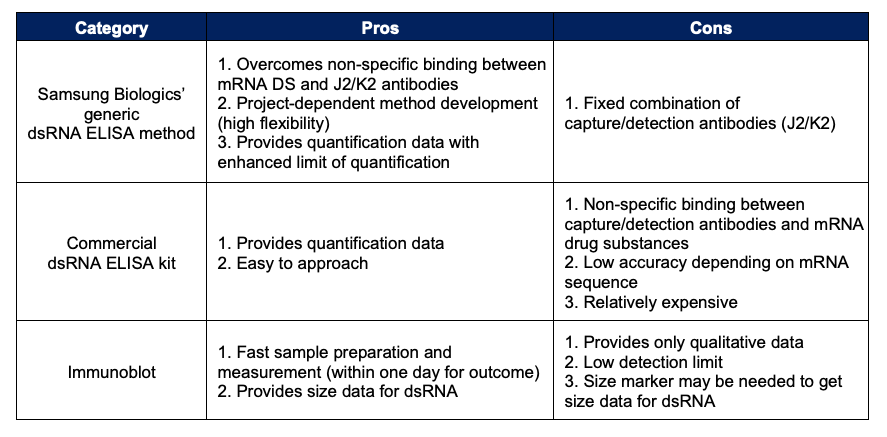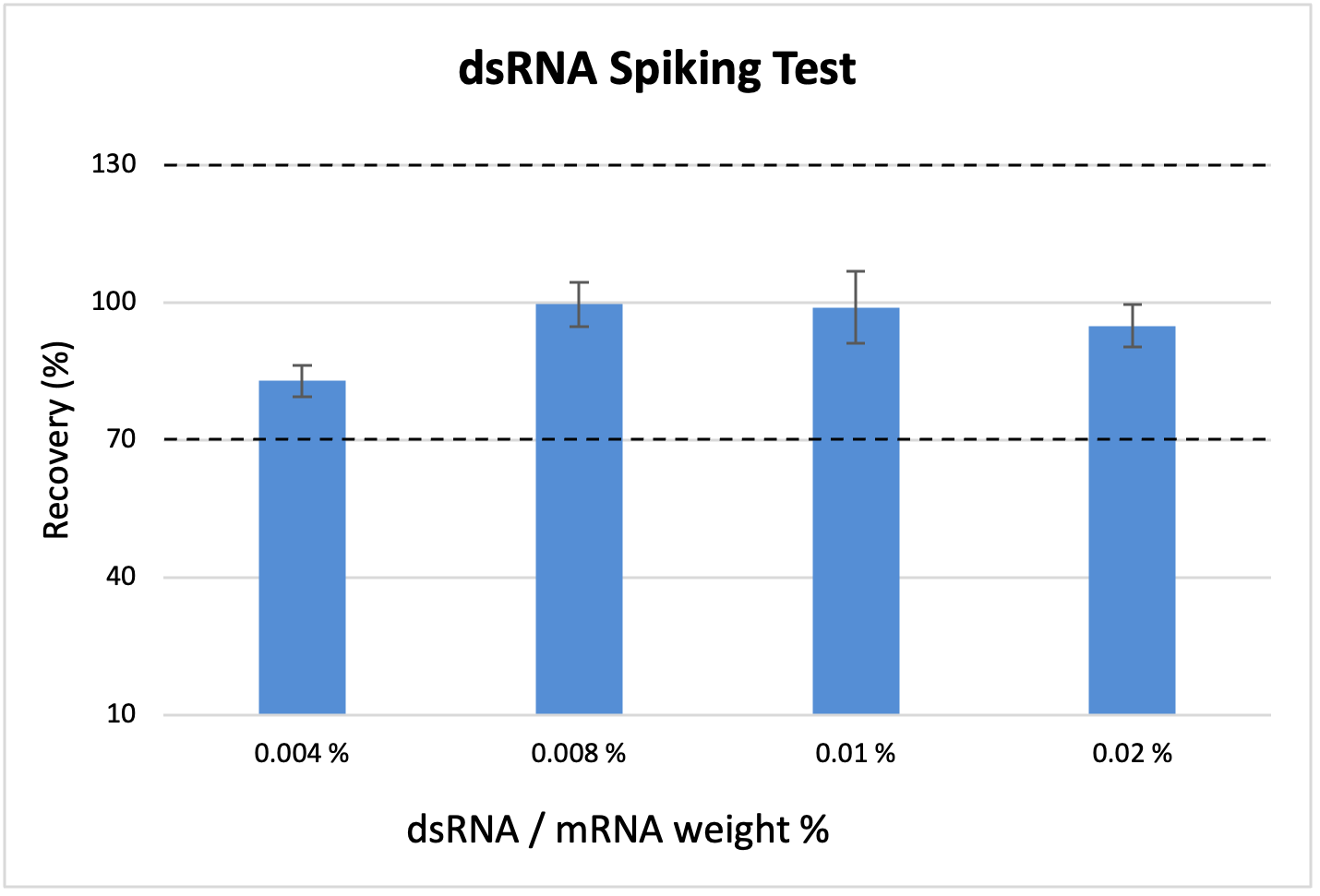The global market for mRNA vaccines and therapeutics, valued at $11.75 billion in 2023, is projected to grow at a compound annual growth rate of 17.05% through 2030.1 This growth is fueled not only by the evolution of COVID-19 vaccines to combat emerging variants but also by the development of mRNA-based solutions for a broad spectrum of infectious diseases, rare genetic disorders, various cancers, and respiratory conditions. Critical to the production process of these therapies is the management of impurities that can compromise safety and efficacy. One of the most challenging impurities to detect and control is double-stranded RNA (dsRNA), a by-product of in vitro transcription known for its high immunogenicity. To ensure greater accuracy and reliability in mRNA therapeutics development, Samsung Biologics has developed a superior enzyme-linked immunosorbent assay (ELISA)-based method for dsRNA detection, offering significant enhancements over traditional commercial ELISA kits.
The Implications of dsRNA in mRNA Therapeutics
Most mRNA therapeutics and vaccines are synthesized through in vitro transcription (IVT) from DNA templates. During this process, double-stranded RNA (dsRNA) can be inadvertently produced as a by-product. This form of RNA, particularly when derived from a virus, is highly immunogenic; it activates several intracellular and endosomal sensors that can trigger inflammation, halt protein synthesis, and even lead to cell death. Consequently, controlling residual dsRNA levels is critical in ensuring the safety and effectiveness of mRNA-based drugs. Global regulatory bodies have set stringent standards, mandating that dsRNA concentrations remain below 0.01% in mRNA drug substances, underscoring its significance as a critical quality attribute (CQA) for RNA-based drugs.
Traditional Method for dsRNA Detection
The immunoblot method has long been a standard approach for detecting dsRNA in mRNA products. Recognized in the 2022 U.S. Pharmacopeia (USP) guidelines for analytical procedures regarding mRNA quality, this method utilizes anti-dsRNA antibodies as diagnostic tools.2 These antibodies can detect a range of pathogens in various sample types, including paraffin-embedded tissue.3 The process involves chemiluminescent detection, where the dsRNA is first separated by gel electrophoresis and then immobilized on a positively charged nitrocellulose membrane using a J2 antibody. This antibody is specifically chosen for its broad reactivity with dsRNA from diverse viruses, such as hepatitis C, dengue, rhinovirus, chikungunya, rabies, polio, classical swine fever, and brome mosaic virus.
While the immunoblot method is appreciated for its simplicity and ease of use, it has significant limitations in terms of sensitivity. It typically detects dsRNA levels above 0.01%, which is the threshold generally accepted for dsRNA-to-mRNA ratio in drug substances. This method also produces results in image format, requiring further data processing for quantitative analysis. The potential for subjective interpretation during this step can compromise precision of the results. Consequently, these characteristics restrict the utility of the immunoblot method to qualitative rather than quantitative assessments.
 Shift to ELISA: A New Standard for Sensitivity and Accuracy
Shift to ELISA: A New Standard for Sensitivity and Accuracy
The transition from immunoblotting to ELISA marks a significant advancement in dsRNA detection technologies. Owing to superior sensitivity and robustness, ELISA-based techniques have set a new benchmark for dsRNA quantitation, quickly becoming the preferred method in the field.
In the ELISA process, dsRNA molecules are first immobilized on an antibody-precoated microplate. They are then bound by a high-affinity anti-dsRNA antibody linked to a reporter enzyme. This complex formation allows for the precise detection and quantitation of dsRNA after washing away any unbound material. The sandwich ELISA, a more specific variation of the standard ELISA, employs two antibodies: one antibody precoated on the substrate to capture the dsRNA and a primary antibody that specifically detects the dsRNA. A highly specific, labeled secondary antibody targets the primary antibody for enhanced detection accuracy. This dual-antibody approach significantly enhances the sensitivity and specificity of the assay.
Referenced in the 2024 third draft of the USP guidelines for "Analytical Procedures for Quality of mRNA Vaccines and The,rapeutics," standard ELISA methods typically employ a combination of K1 and K2 antibodies for the detection of dsRNA.2 In contrast to immunoblot methods, which have lower sensitivity and primarily provide qualitative data, ELISA can accurately quantify dsRNA down to nanogram-per-milliliter levels through its sophisticated limits of quantitation and detection. Additionally, the ELISA format shows high specificity in sandwich assays. It can be adapted to various testing conditions and sample types, setting a benchmark for newer, more tailored approaches to dsRNA quantification.
Despite its advantages, ELISA does require more time — often exceeding a day — and its effectiveness can vary depending on the size of the dsRNA. Many commercially available ELISA kits, use standard J2 antibodies but sometimes yield atypical reactions with mRNA substances in the sandwich format. This underscores the ongoing need for tailored ELISA methods specifically designed for mRNA therapeutics to overcome these challenges.
Customized Precision: Samsung Biologics' Approach to ELISA Development
Recognizing the importance of fit-for-purpose dsRNA detection in mRNA programs, Samsung Biologics has pioneered ELISA technology enhancements to boost the accuracy and reliability of dsRNA quantification. These improvements specifically address limitations observed in commercial ELISA kits, particularly the matrix effects that can skew dsRNA measurements in mRNA drug substances.
The initial feasibility tests were performed with commercial dsRNA ELISA kits; however, there was a challenge, as the ELISA detection antibodies can interact with the mRNA in the sample, potentially leading to inaccurate estimation of dsRNA levels. By incorporating a minimal amount of mRNA into the calibration standard, Samsung Biologics effectively countered this interaction, ensuring a more accurate estimation.
Samsung Biologics developed a specialized J2/K2 sandwich ELISA with dsRNA concentrations ranging from 2 to 40 ng/mL alongside a specific level of mRNA drug substance. Additionally, two distinct mRNA samples, AcGFP and Cas9, were evaluated across dsRNA concentrations of 4 and 40 ng/mL. Recovery rates in these assessments varied between 95% and 110%, with coefficients of variation ranging from 1.6% to 7.5%. The dsRNA content was measured at 0.028% in the AcGFP samples and 0.022% in the Cas9 samples, underscoring the enhanced precision of this innovative ELISA technique.
 Figure 1. dsRNA spiking test recovery
Figure 1. dsRNA spiking test recovery
Further qualifications of the J2/K2 sandwich ELISA method were conducted with a working range of 0.004% to 0.02% dsRNA/mRNA (w/w). The results consistently fell within the optimal recovery range of 70% to 130% and maintained precision under 25%. The calibration was successfully repeated, reaffirming the method’s robustness (Figure 1).
Leveraging Samsung Biologics’ Expertise for Enhanced Therapeutic Safety
Beyond the initial dsRNA analytical methods, Samsung Biologics has refined a range of validated techniques using essential antibodies for comprehensive dsRNA testing, enabling tailor-made ELISA methods. These methods are specifically optimized to the unique requirements of each client, selecting antibodies that best detect dsRNA across varied lengths and are tailored to the specific mRNA drug substance involved. A distinct advantage of our method is its ability to accurately measure dsRNA in mRNA drug substances, even in the presence of non-specific reactions between certain mRNA sequences and J2/K2 antibodies. To enhance the assay’s specificity, we integrate a specific level of mRNA DS into both the standard and sample solutions. In order to validate this approach, we used AcGFP and Cas9 mRNA samples, and we anticipate this will be applicable to various other mRNA sequences from numerous clients, demonstrating the method’s broad potential utility.
Partnering with Samsung Biologics enables access to these specialized, advanced dsRNA analysis solutions, ensuring that clients benefit from cutting-edge, precise, and purpose-fit testing capabilities. The deep analytical expertise of Samsung Biologics’ subject matter experts, who can integrate commercially available ELISA kits as needed based on the availability of raw materials, further enriches this partnership. Consequently, engaging with Samsung Biologics significantly reduces the immunogenicity risks associated with mRNA drug substances by providing reliable and accurate dsRNA detection.
Conclusion
Accurate dsRNA detection is crucial for ensuring the safety and effectiveness of mRNA-based therapeutics and vaccines. Traditional methods like immunoblotting, while useful, fall short when providing quantitative data. Conversely, ELISA techniques offer high sensitivity and robustness but can suffer from inaccuracies due to matrix effects when using commercially available kits.
Samsung Biologics has addressed these challenges with its enhanced ELISA technology, which not only mitigates the typical limitations associated with standard kits but also allows for the tailored development of solutions to detect dsRNA of various lengths. We invite developers of mRNA vaccines and therapies seeking enhanced dsRNA detection capabilities to explore the advanced technologies offered by Samsung Biologics. Whether for application in-house or as an external service, we design our solutions to integrate seamlessly into existing mRNA development workflows, ensuring superior accuracy and reliability in dsRNA quantification.
References
1. mRNA Therapeutics Market Size, Share & Trends Analysis Report By Application (Rare Genetic Diseases, Oncology, Respiratory Diseases, Infectious Diseases), By Type (Prophylactic, Therapeutic), By End-use, By Region, And Segment Forecasts, 2024 – 2030. Grand View Research. 2024.
2. Analytical Procedures for Quality of mRNA Vaccines and Therapeutics Draft guidelines: 3rd Edition. USP-NF. Accessed 15 Jul 2024.
3. Richardson, S.J. et al. “Use of antisera directed against dsRNA to detect viral infections in formalin-fixed paraffin-embedded tissue.” J. Clin. Virol. 49: 180–185 (2010).

